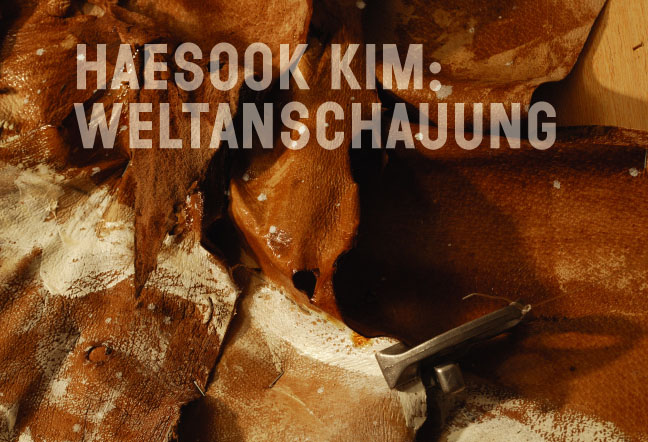HAESOOK KIM
WELTANSCHAUUNG
November 3, 2004 to December 23, 2004

According to the philosopher
Wilhelm Dilthey, a thinker’s or an artist’s Weltanschauung
is not really his imaginative “vision of the world”; it is
his comprehensive answer to the question “What is the meaning of
life?” Haesook Kim’s lifelong inquiry into “the riddle
of life” necessarily includes the metaphysical or the afterlife.
She began her search as a youngster when her artistic imagination led
her to investigate the phenomena of the lifecycle. She buried dead animals
in transparent coffins or cultivated plants in glass containers in an
effort to preserve their beauty and color but instead witnessed their
subsequent degeneration and eventual passing. And, while carefully monitoring
these changes she experienced the realization of death even while expecting
to see the emergence of a soul. Nevertheless, even now as an adult, she
persists in her attempts to regenerate, renew, revitalize and breathe
life into her medium—inert skins—that she arranges into flowers.
Kim’s formal reason for using skin as her medium is its pliability,
which allows her to stretch the hide into position while maintaining its
original uncut configuration. Kim’s interest in floral motifs predates
her graduation with a B.A. from Ehwa Women’s University in Seoul
in 1977, and her subsequent M.A. at Kyung Hee University. It dates back
to her early experiences with planting flowers, cultivating their growth,
awaiting their bloom, and hoping she could somehow prolong their life.
While she demonstrated natural artistic talent at an early stage, and
won many prizes in Junior High and High school competitions, it was during
her Master’s program that she constructed works with folded and
colored papers. In an effort to break with the canvas edge she folded
papers while respecting their wholeness into origami-like configurations.
After this point she developed her style into 3-dimensional installations
made of canvas, as is her painted tent entitled Forgotten Story, 1990.
Then around 1992 she worked with found objects, coloring them, and adding
small portions of leather to her works while allowing their fastenings;
staples for example, to maintain their raw state as in her Melody, 1992.
In 1994 she began to combine tent canvases with animal hides stretching
them with hooks and eyes without cutting them. She developed her techniques
through printing on acrylic and leather in layers with on-lays of silk-screening
as seen in her mixed media work Metamorphosis, 1995. Soon after this she
left color behind to engage directly with the naked skins creating oversized
flowers in neutral tones adding resin, dripped melted wax, chalk and charcoal
as in her construction Metamorphosis, 1996.
Kim became interested in certain stamped brands on the leather she
purchased from the wholesale market for example 5.75 pyon (centimeters)
x 350 won (monetary value). The markings caused Kim to think about the
value of life and about what remains on earth after a living creature
dies. The process reminds her of a passage in the Buddhist Sutra of Impermanence;
that one is born of skin and bone to return to the earth, while blood
and saliva are liquids that revert to water, and energy becomes fire.
Her 1997 Metamorphosis is a work, which has stylistically become more
violent and less about beauty. In its focus on deterioration, entropy
and expressionist movement it becomes like the wind--and like the four
elements will eventually return to its natural habitat. Kim attended the
Art Students League while living in New York between 1999 and 2001 to
sketch and draw the human form and created small works. Her sustained
interest lies in death and its mysteries, the afterlife and its rituals
such as that of rice offerings to the dead. Most recently Kim has intensified
her investigations into the meaning of life and death due to her mother’s
passing and she has changed from using pigskins to cowhide as well as
color. This return to color does not include the full prism but rather
is confined to the color ochre used in this series, which is reminiscent
of the dried blood of slaughtered animals. The pragmatic reason for Kim’s
switch to cowhide is due to her need for a larger format or animal hide,
but its symbolism is also important to the artist. This installation represents
the gestation period of the last few years that derives inspiration from
her travels and studies into the area of metaphysics and the use of skin
that symbolizes the physical detritus of life.
|
 |
